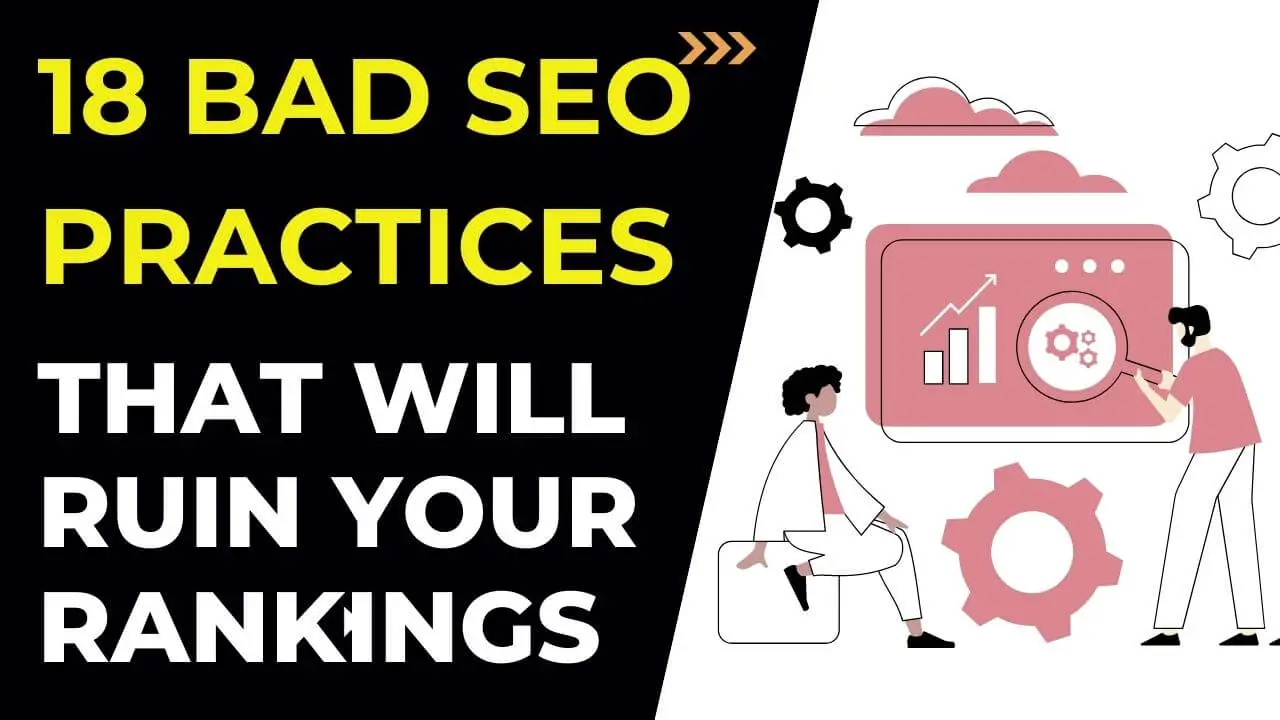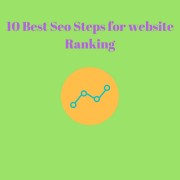18 Bad SEO Practices that Will Ruin Your Rankings
If you're using black-hat SEO tactics to try and boost your website's ranking, you're doing it wrong. Not only will these methods get you penalized by Google, but they also won't work in the long run.
In this post, we wanted to take a moment to inform you about some of these bad SEO practices that can potentially scare your visitors into looking for bots on your website and compromise your online presence. We know that you will never use such unethical practices, but if you have wrong information from an online "SEO guru" you can make sure you don't use any of the bad SEO practices from this list. Techniques that are unethical, outdated, or outside of Google's webmaster guidelines are considered "bad SEO".

It is called as black hat and often violates Google's terms of service, which include hidden text, keyword stuffing, and spamming among other dirty tricks. Black Hat SEO basically refers to SEO strategies that manipulate Google's search to boost a website's rankings. Masking also aims to trick Google's algorithm so that a website can rank for multiple keywords that are irrelevant to the content available.
For example like cheap guest posts, low-quality domains, and unwanted links are easily identified by Google, which in turn reduces website traffic. If most of your links appear on websites filled with spam and irrelevant content, your site will be more likely to be penalized, even if your content is perfectly respectable.
In the past, webmasters trying to cheat the system have gone as far as inserting each variation of a high-value keyword into the website footer, or, even simpler, making those keywords the same color against the background of the site, effectively hiding it. them from people, but not from search engine crawlers. This tactic evolved and eventually helped create many content farms that targeted traffic solely on keyword value and visibility targeting.
Many outdated and misguided SEO tactics can negatively impact your site rankings and user experience. So in this article, we will discuss about bad Seo Practices
18 Bad SEO Practices that Will Ruin Your Rankings
Dupliicate Content
Duplicate content is a situation where there is more than one version of a given piece of content on the internet. This can be caused by a variety of reasons, such as multiple websites using the same content, or different websites republishing content from other sources without permission.
Duplicate content can be damaging to your website's SEO, as it can lower your site's ranking in search engine results pages. It can also confuse search engines and cause them to penalize your website.
There are a few ways to avoid duplicate content issues:
- Make sure you are the only website publishing content that is original to your site.
- If you are republishing content from other sources, make sure to credit those sources correctly.
- Use a canonical URL tag to tell search engines which version of a piece of content is the original.
- If you are using a content management system (CMS), make sure to enable canonical URLs.
Links from bad websites
Links from websites that are not related to your topic can confuse your readers and make them lose interest in your article. If you must include a link from a website that is not related to your topic, make sure that it is a reputable website. Links from websites with low Domain Authority can harm your website's SEO ranking.
When it comes to SEO, the quality of your inbound links matter just as much as the quantity. In fact, links from bad websites can actually hurt your rankings.
Here’s how it works: Google’s algorithm looks at both the quantity and quality of your inbound links when determining your website’s ranking. So, if you have a lot of links from low-quality websites, your rankings will suffer.
There are a few ways to tell if a website is low quality:
- The website is filled with ads
- The website has little to no content
- The website is not updated regularly
If you’re buying links or getting them from directories, be sure to check the quality of the website first. Otherwise, you could be doing more harm than good.
Keyword Stuffing
When it comes to SEO, one of the most frowned-upon practices is keyword stuffing. This is when you stuff your keywords into your content in an attempt to rank higher in search engine results pages.
Keyword stuffing is the act of filling a web page with keywords or numbers in an attempt to manipulate a site's ranking in Google search results. Keyword Stuffing is one of bad seo practices .Yes, keyword stuffing is a black hat SEO technique that can get your website penalized by Google.
Keyword stuffing used to be a really effective way to improve your ranking. But search engines have gotten wise to this tactic, and now it can actually hurt your ranking.
If you stuff your keywords too much, your content will become difficult to read and your page will be penalized by search engines. So how can you use keywords effectively without stuffing them?
Here are a few tips:
- Use keywords whenever required, Only use them where they make sense.
- Use long-tail keywords. These are keywords that are more specific and less competitive.
- Use related keywords. This helps search engines understand the context of your content better.
- As a start, you can include keywords throughout your content, including in the title, body text and in the section of your website dedicated to keywords.
- By following these tips, you can use keywords effectively without keyword stuffing.
Low Quality Blogpost
A low quality blog post is not good for SEO. This is because search engines like Google place a high importance on the quality of content when determining where to rank a website in search results. If your blog posts are of low quality, it is likely that your website will not rank as highly as it could in search engine results pages.
This is why it is important to make sure that your blog posts are well-written and informative. If you are not a good writer, you may want to consider hiring a professional to write your blog posts for you. However, even if you are a good writer, it is still important to edit and proofread your work before publishing it. A good rule of thumb is to read your blog post aloud to yourself before hitting the publish button. This will help you catch any errors or awkward phrasing.
If you want your website to rank well in search engine results pages, make sure that you are writing high quality blog posts. This is the best way to ensure that your website gets the visibility it deserves.
So why settle for anything less than the best when it comes to your blog posts? Take your blog to the next level of mediocrity!
Cloaking
What is Cloaking?
Cloaking is a black hat SEO technique employed to deliver different content to search engine crawlers than what is delivered to human users. This is done with the intent of manipulating search engine rankings. Cloaking is considered a deceptive SEO practice and is against the guidelines set by major search engines like Google.
How does Cloaking work?
A common way to cloak content is to use a user-agent sniffer. This is a piece of code that checks the user-agent of the visitor and then serves up different content depending on whether it’s a search engine crawler or a human user.
Another way to cloak content is to use IP delivery. This method checks the IP address of the visitor and serves up different content depending on the IP address. This is generally considered to be a more sophisticated cloaking technique.
Why do people use Cloaking?
Cloaking is usually employed with the intention of improving search engine rankings. By delivering different content to search engine crawlers, a website can tries to game the system and achieve a higher ranking than they would otherwise.
However, cloaking is a black hat SEO technique and is frowned upon by the major search engines. Using cloaking can result in a website being penalized or even banned from a search engine. Therefore, it’s not a technique that we would recommend using.
Links to text ratio
Having too many links in your text can be a turnoff for readers. If your text is loaded with links, it can be difficult to read and follow. Too many links can also be seen as spammy, which can hurt your reputation.
To avoid this, make sure to keep your links to text ratio reasonable. A good rule of thumb is to have no more than one link for every 100 words of text. This will ensure that your text is easy to read and that your links are not excessive.
Hidden keywords
If you're a content creator, it's important to be aware of the hidden keywords in your content. These are the words and phrases that you may not think are important, but they can actually be the key to getting your content seen by more people.
For example, let's say you're writing a blog post about fitness. You might not think to include the word "gym" in your post, but if someone is searching for "fitness" and "gym" together, your post is more likely to come up. So, it's important to include all relevant keywords, even if they seem unnecessary.
Another tip is to use long-tail keywords. These are keyword phrases that are more specific than just a single word. For instance, instead of just using the keyword "fitness," you could use "fitness for beginners," "fitness for weight loss," or "fitness for seniors." Long-tail keywords are often less competitive, but they can still be effective in getting your content seen.
It's not too late to start utilizing social media for your business's success, Just make sure you draft a compelling post and encourage people to share it with their friends.. When you share your content on social media, be sure to use hashtags and to tag relevant people and pages. This will help more people see your content and it may even be shared by others.
By following these tips, you can make sure that your content is seen by more people and that you're using all the right keywords. So, don't overlook the hidden keywords in your content - they could be the key to success!
Buying links from Third-party Sites
There has been a lot of debate in the SEO community lately about whether or not buying links is a good idea. Some people say that it's a great way to get your website to rank higher in the search engines, while others claim that it's a waste of money and can actually hurt your website's ranking.
So, what's the truth? Is buying links a good idea or not?
Well, in my opinion, buying links is not a good idea for several reasons. First of all, it's against the guidelines set forth by Google. If you're caught buying links, you could receive a penalty from Google that could severely hurt your website's ranking.
Second, even if you're not caught by Google, buying links is still a risky proposition. The quality of the links you purchase can vary greatly, and if you end up with a bunch of low-quality links, it could still hurt your website's ranking.
Finally, even if you do find some high-quality links, there's no guarantee that they will actually help your website's ranking. In many cases, the links you purchase may have little to no impact on your website's ranking.
So, in conclusion, buying links is not a good idea. It's against the guidelines set forth by Google, it's risky, and it may not even help your website's ranking.
Misleading Headlines
Misleading headlines are easy task to create. But they were very effective for the website that is publishing them before. They are effective because they will get people to click on the article and then once they are on the website, there is a chance that those people will stay and browse through more of the site's content.
However, misleading headlines do come with some risks. One risk is that Google might penalize a site for using misleading headlines because it can affect their rankings in search engine results pages. This penalty could end up affecting other parts of their website as well, like their organic traffic or even their conversion rates.
Slow Hosting Provider
Slow hosting is not good for SEO because you cannot have high traffic and conversions, so your website will not rank in search engines. SEO is a big process, It also includes a website’s loading speed. A slow website will show up higher in search engine results pages and have lower click-through rates from the search engine results pages to the site. Slow loading times make a page less appealing which can lead to lower conversion rates and revenue potential.
If a website is hosted on the wrong server, the website will not be able to deliver a high-quality user experience. This is because the hosting service determines how fast a site loads and how well it functions. Websites need steady, fast hosting to deliver the best user experience. and that's why it's so important for webmasters to select their hosts carefully before they sign to any plans.
Too many ads
It is not a good idea to have too many ads on your website. In fact, it can have a negative impact on your search engine optimization ranking.
The more advertisements you generate, the more of your content will be replaced by advertisements and the less organic content will show up on your site. It may also lead to a lower ranking for your site in the Google search engine.
Ads can be a great way of generating revenue, but they can also affect the SEO performance of a website. Too many ads on a page can confuse the user and make them leave the site. This is because they don't know which one to click on and it's not what they were expecting when they clicked on the link.
The number of ads that are placed on a page should be limited to no more than two or three per page. This will ensure that there are no distractions for the user and that their attention is completely focused on clicking on the desired link.
Article Spinning
Article spinning is a process of rewriting an article with the same meaning but in different words. It can be done manually or by using software. The goal of this process is to avoid plagiarism and to make the content seem more unique.
Article spinning might seem like a good idea at first, but it can be bad for SEO. Google and other search engines are getting better at detecting spun content, which means that article spinning can actually do more harm than good.
The problem with article spinning is that it can be easily detected by Google's algorithm and penalized. This means that your bounce rates will be high and your page time will be low.
The Negative Aspects of Article Spinning for SEO
There are a lot of people who use article spinning for SEO purposes. It is not a new technique and it has been around for many years now. However, there are some negative aspects that you need to be aware of.
The first thing that you should know is that article spinning is not the same as article marketing. The difference is that article marketing is when you write an original piece of content and then promote it on social media or other channels whereas with article spinning, you are just rewriting the same content as it was before but changing words so that Google does not penalize your site for duplicate content violations.
The first thing to know about article spinning is that it can be an incredibly useful tool for SEO. The key to using this technique successfully is to not abuse it by over-utilizing spun articles, or by re-posting an original article without making the necessary changes.
Why should you Avoid Article Spinning?
The main issue with article spinning is that it can lead to duplicate content, which can have negative consequences for your site’s SEO. It may also be against the law in some countries, such as Germany and France.
Finally, it is not a good technique for SEO because it is not natural. With so many other ways to improve your website’s SEO, it’s worth avoiding article spinning at all costs.
Exact match keyword domains
An exact match domain is a domain name that matches the keyword of the domain. These domains are often referred to as "keyword domains" since they are so closely related to their content. . A domain like "toys.com" would be an exact match domain for "toys" and "com", because the keyword of both domains is toys.
Exact Match Domain Names are very popular among marketers in Early 2010 because they are easy to remember, and they can help increase the click-through rate. They also provide a better brand experience for consumers. But it is a risk that these domains will become obsolete as more people use this method.
Exact match domains are not good for SEO because it is difficult to rank for a keyword that is also your domain name. This can be an issue if you want to rank for a specific keyword without having to use other keywords in your content. Exact-match domains will be penalized for using a keyword that is also your domain name. Many people have taken advantage of using exact match keyword domain thus creating difficulty to rank quality sites against these sites. but provides an advantage if you have a broader keyword to rank for.
Low Quality Backlinks
Low quality backlinks are links on sites that do not have a lot of authority in the search engine rankings. The search engines consider these links as spammy and ignore them because they don’t want to be manipulated by low quality websites. Low quality backlinks are harmful to SEO as they used to be. Google has been using a lot of factors other than backlinks in their ranking algorithm.
Google has been changing their algorithm to make it more difficult for low quality sites to rank well on search engine pages. Backlinks are still an important factor, but they are not the only one anymore.
How low quality backlinks affects Seo?
One of the most important factors that affect your site ranking is the number of backlinks you have. To increase your Google ranking, you need to acquire as many quality backlinks as possible. However, there's a problem: fake or low-quality backlinks can slow down your site's growth and even cause it to be banned by Google.
How to find low quality backlinks?
Backlinks, or hyperlinks from other sites directed at an individual site, are a fundamental part of search engine optimization. For example, a link from Wikipedia to the website is considered high quality because it is authoritative and relevant to the website. A low quality backlink, on the other hand, might be a link from a spammy blog that has nothing to do with your website.
Find quality backlinks using Google Search Console
Backlinks are the number of links on one webpage pointing to another webpage and Google Search Console is a program that allows webmasters to view and manage their website's data in Google Search.
Which is why you should use Google Search Console to find relevant websites linking to your site. Just goto Links in left sections of tab.
Bad user experience
How Bad Website user Experience Impact SEO Performance?
Bad user experience can impact SEO performance, because it’s hard for search engines to crawl and index a website that isn’t user-friendly. But there’s also the impact of user experience on content. If it’s too difficult to use a website, people will leave and search for better options, which can mean that all the time invested on content is wasted. The goal of this update was to make it easier for users to find what they need on our site and explore it.
There are some insights on how to create a good user experience for SEO purposes. It will provide you with some awesome tips that you can use in order to create a good user experience for your website.
My goal in this topic is to help you understand what makes a good user experience and what makes website bad experience overall impact your Seo performance and how you can make better.
Why is it Important for SEO?
Website User Experience is the process of designing a website in such a way that it is easy to use, aesthetically pleasing and meets the needs of its users. A website’s user experience can be judged by how easy it is to navigate, how much time it takes to find information and how satisfied the website’s visitors are with their experience.
User Experience design is important for SEO because it can affect how your content will rank on search engines. If you want your content to rank higher, then you need to make sure that the design of your page is good and that it will provide a good user experience for your visitors.
Intrusive Popups
Intrusive popups are a form of online advertising that is designed to interrupt the user's browsing experience. They often appear as an overlay on top of a website, and they're usually designed to promote a product or service.
The two main issues with intrusive popups are that they can be annoying and disruptive for the user, and they can potentially affect the site's SEO performance.
Popups are not inherently bad for your website's SEO, but if you use them in an intrusive manner (i.e., without providing users with an easy way to close them), then they can affect your website’s rankings in search engines like Google. Google has been known to penalize sites that use too many intrusive pop-ups; therefore it is important to be mindful of how you
The following are some points to consider when designing a website:
- Think about the purpose of your site and ensure that navigation is clear.
- Keep the content on the page relevant and concise.
- Use a small number of ads.
- Avoid more intrusive popups ad scripts.
Higher Bounce Rate
Bounce Rate is a not a ranking factor in Google's algorithm. It is used to determine the quality of a website and how much it deserves to rank higher.
The bounce rate is calculated by dividing the number of visits by the number of page views and it will be displayed as a percentage. A high bounce rate may indicate that there are some issues with your site, such as low-quality content or difficult navigation, which might be lowering your rankings.
Bounce Rates Impact On SEO & Search Rankings
When it comes to SEO, bounce rates are the metric that most people focus on. The bounce rate is a percentage of the number of single-page sessions (visits where a person leaves the site from the entrance page without interacting with the page) to total visits. Bounce rates can be an indication of how engaging and compelling your website is.
Websites live and die by the bounce rate. A high bounce rate is a sign of bad content, which means visitors are leaving the site immediately. Here are some tips you can use to reduce your bounce rates Avoid long, boring content, slow loading time, too many ads, low quality content and much more. There's nothing wrong with getting traffic, but make sure that people are motivated to read it (e.g., by having a good story or unique angle).
Buildings links too fast
A website is like a building. It needs to be built slowly and steadily over time, with the foundation being laid first. It also needs to be continuously updated so that it can grow and evolve with the times.
The first thing you need to do is analyze your site for any problems that might affect its SEO ranking. If there are any, then you will need to fix them before you start building links.
Once you have fixed these problems, then it's time to start building links - but not too fast or they will not help your SEO ranking at all! Quality links are a type of link that has been created by end users. This means that the link has been automatically generated and not manually created. These types of links generally have lower rankings in SERPs because they often lack the authority you need to rank well.
Conclusion
There are many people still use some of bad SEO practices. It is important to follow Google's guidelines and to have high quality content to mobile friendly website. Some of the mistakes in SEO makes difficult to rank for the long term and may hit with penalties of Google which leads loss of time, energy and business.
It is worth noting that despite the many advances in SEO, there are still many people who are using some of the bad methods. This information is very important for those want to rank their website on Google.





